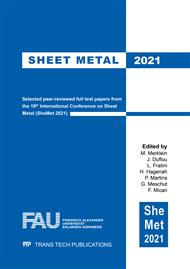[1]
Klocke, F.: Manufacturing Processes 4: Forming. Berlin: Springer Verlag, 2013, pp.429-453.
Google Scholar
[2]
Chen, Z.H., Chan, L.C., Lee, T.C., Tang, C.Y.: An investigation on the formation and propagation of shear band in fine-blanking process. In: Journal of Materials Processing Technology 138, 2003, pp.610-614.
DOI: 10.1016/s0924-0136(03)00141-9
Google Scholar
[3]
Weiser, I.F., Mannens, R., Feuerhack, A., Trauth, D., Bergs, T.: An analytical approach for the determination of the temperature distribution in the cross section of a sheet metal caused by inductive heating. Procedia Manufacturing, Vol. 29, 2019, pp.353-360.
DOI: 10.1016/j.promfg.2019.02.148
Google Scholar
[4]
Baer, O., Feuerhack, A., Voigts, H., Bergs, T.: Investigation of the mechanical punch loads during fine blanking of high-strength steels with cemented carbide. In: Procedia Manufacturing 34, 2019, pp.90-100.
DOI: 10.1016/j.promfg.2019.06.125
Google Scholar
[5]
Liu, Y., Hua, L., Mao, H., Feng, W.: Finite element simulation of effect of part shape on forming quality in fine-blanking process. In: Procedia Engineering 81, 2014, pp.1108-1113.
DOI: 10.1016/j.proeng.2014.10.211
Google Scholar
[6]
Zhuang, X., Zhang, W., Wu, Y., Zhao, Z.: Comprehensive prediciton method for die-roll height of fine-blanking components. In: International Journal of Advanced Manufacturing Technology 98, 2018, pp.2819-2829.
DOI: 10.1007/s00170-018-2430-y
Google Scholar
[7]
Spišák, E., Majerníková, J., Spišáková, E.: The influence of punch die-clearance on blanked edge quality in fine blanking of automotive sheets. In: Materials Science Forum Vol. 818 (2015), pp.264-267.
DOI: 10.4028/www.scientific.net/msf.818.264
Google Scholar
[8]
Bubphachot, B.: Microstructure affecting cutting quality in fine blanking process. In: American J. of Engineering and Applied Sciences 2 (4), 2009, pp.665-668.
DOI: 10.3844/ajeassp.2009.665.668
Google Scholar
[9]
Voigts, H., Trauth, D., Feuerhack, A., Mattfeld, P., Klocke, F.: Dependencies of the die-roll height during fine blanking of case hardening steel 16MnCr5 without V-ring using a nesting strategy. In: Int J Adv Manuf Technol, 2018, 95, pp.3083-3091.
DOI: 10.1007/s00170-017-1313-y
Google Scholar
[10]
Zheng, Q., Zhuang, X., Zhao, Z.: State-of-the-art and future challenge in fine-blanking technology. In: Production Engineering 13, 2019, pp.61-70.
DOI: 10.1007/s11740-018-0839-7
Google Scholar
[11]
Weiser, I.F., Hild, R., Feuerhack, A., Trauth, D., Bergs, T.: Experimental investigation of oxide layer formation depending on temperature holding time during inductive heating of annealed 16MnCr5. In: Procedia Manufacturing 47, 2020, pp.1328-1333.
DOI: 10.1016/j.promfg.2020.04.253
Google Scholar
[12]
Zimmermann, M.: Feinschneiden von Schrägverzahnungen. Doctoral thesis, RWTH Aachen University, (2015).
Google Scholar
[13]
Raedt, H.W.: Grundlagen für das schmiermittelreduzierte Tribosystem bei der Kaltumformung des Einsatzstahles 16MnCr5. Doctoral thesis, RWTH Aachen University, (2002).
Google Scholar
[14]
Merklein, M., Lechler, J.: Investigation of the thermo-mechanical properties of hot stamping steels. In: Journal of Materials Processing Technology 177, 2006, pp.452-455.
DOI: 10.1016/j.jmatprotec.2006.03.233
Google Scholar
[15]
DIN EN 10277:2018: Bright steel products – Technical delivery conditions; German version, DIN Deutsches Institut for Normung e.V.
Google Scholar
[16]
DIN EN 10149-2:2013: Hot rolled flat products made of high yield strength steels for cold forming – Part 2: Technical delivery conditions for thermomechanically rolled steels; German version. Deutsches Institut für Normung e.V.
DOI: 10.3403/30239495
Google Scholar
[17]
DIN EN ISO 6508-1: Metallic materials- Vickers hardness test – Part 1: Test method, 2018, DIN Deutsches Institut für Normung e.V.
Google Scholar
[18]
Shadad, S.A., McCabe, J.F., Bull, S., Rusby, S., Wassell, R.: Hardness measured with traditional Vickers and Martens hardness methods. In: Dental Materials, Vo. 23, Iss. 9, 2007, pp.1079-1085.
DOI: 10.1016/j.dental.2006.10.001
Google Scholar


